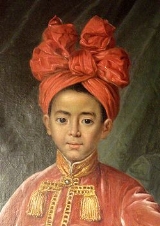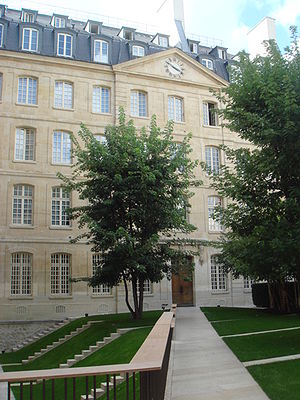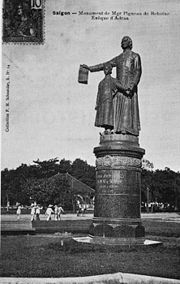
Nguyen Phuc Canh
Encyclopedia
Nguyễn Phúc Cảnh
Nguyễn Phúc Cảnh (1780–1801, also known as Prince Cảnh, was the eldest son of the Vietnamese Prince Nguyễn Phúc Ánh, the future Emperor Gia Long
. At the age of seven, he famously visited France with the French Catholic Father Pigneau de Béhaine
to sign an alliance between France and Vietnam
. Although Prince Cảnh was the legitimate heir to the throne, he died before his father, and none of his descendants ascended the throne after one of his half-brothers was chosen by Gia Long.
(his older brother died soon after birth).
to France in order to sign a treaty of alliance between France and Vietnam, the 1788 Treaty of Versailles. Prince Canh was also accompanied by two mandarins
, a cousin, who became a Catholic known as Prince Pascal, soldiers and servants. The party reached Pondicherry in February 1785. Unable to obtain help, they left Pondicherry for France in July 1786. which they reached in February 1787.
The party met with King Louis XVI on May 5 or 6, 1787. The Treaty of Versailles (1787)
was signed on 28 November 1787. Prince Cảnh created a sensation at the court of Louis XVI, leading the famous hairdresser Léonard to create a hairstyle in his honour "au prince de Cochinchine". His portrait was made in France by Maupérin
, and is now on display at the Séminaire des Missions Étrangères in Paris. Prince Canh dazzled the Court and even played with the son of Louis XVI, Louis-Joseph, Dauphin of France.
 Prince Canh became highly favourable to Christianity. He strongly desired to be baptized, but Pigneau de Behaine refrained doing so in order to avoid a negative reaction at the Vietnamese court.
Prince Canh became highly favourable to Christianity. He strongly desired to be baptized, but Pigneau de Behaine refrained doing so in order to avoid a negative reaction at the Vietnamese court.
In 1793, Nguyễn Phúc Cảnh became "Crown Prince of the Eastern Palace". From 1794 he participated to all the military expeditions, and his father Nguyễn Ánh insisted that he be accompanied every time by Father Pigneau de Behaine. He was besieged by the Tây Sơn with Pigneau de Behaine in the citadel of Duyen Khanh in 1794.
After Pigneau de Behaine died at the Siege of Quy Nhon in 1799, Prince Cảnh made a funerary oration to his former master:
 Prince Canh seems to have been baptized secretly towards the end of his life. According to Vietnamese annals:
Prince Canh seems to have been baptized secretly towards the end of his life. According to Vietnamese annals:
He died in 1801 of smallpox. Missionaries claimed however that he was poisoned. As Nguyễn Phúc Cảnh was the presumptive heir to Gia Long, Canh's eldest son Mỹ Đường was next in line for the succession.
Gia Long however changed the primogeniture
rule of succession to include "testamental measures" (gia thien ha), and ultimately changed his successor to the fourth son of one of his concubines, who became emperor Minh Mạng
.
 In 1824, My Duong, the eldest son of Prince Canh, was apparently accused of incest with his mother (Prince Canh's widow) by mandarin Lê Văn Duyệt
In 1824, My Duong, the eldest son of Prince Canh, was apparently accused of incest with his mother (Prince Canh's widow) by mandarin Lê Văn Duyệt
, with the result that he was banished from the royal court, while his mother died in prison. My Duong was only rehabilitated in 1848 during the reign of Tự Đức, one year before his death.
The 1833-1835 Le Van Khoi revolt
attempted to reestablish Prince Canh's line to the throne. This choice was designed to obtain the support of Catholic missionaries and Vietnamese Catholics, who had been supporting with Lê Văn Duyệt
the line of Prince Canh.
My Duong's eldest son was Le Trung, who received the title of Marquis Ứng Hòa Hầu in 1826. Le Trung's eldest son was Anh Nhu (also known as Tang Nhu), who was considered as a candidate to the throne under French rule, following the establishment of the protectorate on Annam in 1884, and once again after the death of Đồng Khánh in 1889.
Anh Nhu, grand-grandson of Prince Canh, was the father of Cường Để, the eldest son of three, who became a well-known independentist and collaborator with the Japanese during World War II. Cường Để, according to the old rule of primogeniture was the heir of the Nguyễn Dynasty.
Nguyễn Phúc Cảnh (1780–1801, also known as Prince Cảnh, was the eldest son of the Vietnamese Prince Nguyễn Phúc Ánh, the future Emperor Gia Long
Gia Long
Emperor Gia Long , born Nguyễn Phúc Ánh , was an emperor of Vietnam...
. At the age of seven, he famously visited France with the French Catholic Father Pigneau de Béhaine
Pigneau de Behaine
Pierre Joseph Georges Pigneau , commonly known as Pigneau de Béhaine, also Pierre Pigneaux and Bá Đa Lộc , was a French Catholic priest best known for his role in assisting Nguyễn Ánh to establish the Nguyễn Dynasty in Vietnam after the Tây Sơn...
to sign an alliance between France and Vietnam
Vietnam
Vietnam – sometimes spelled Viet Nam , officially the Socialist Republic of Vietnam – is the easternmost country on the Indochina Peninsula in Southeast Asia. It is bordered by China to the north, Laos to the northwest, Cambodia to the southwest, and the South China Sea –...
. Although Prince Cảnh was the legitimate heir to the throne, he died before his father, and none of his descendants ascended the throne after one of his half-brothers was chosen by Gia Long.
Life
Born April 6, 1780, Nguyễn Phúc Cảnh was the second son of Nguyễn Phúc Ánh and his first wife, Empress Tống Thị LanThua Thien (empress)
Empress Thừa Thiên , born Tống Thị Lan, was the first wife of Nguyen Phuc Anh and mother of Crown Prince Nguyen Phuc Canh. She was a daughter of general Tống Phước Khuông of Nguyễn lords. Nguyễn Ánh married her when he was at the age of 18...
(his older brother died soon after birth).
Embassy to France
In 1785, at the age of five, Nguyễn Phúc Cảnh accompanied the French Catholic Father Pigneau de BéhainePigneau de Behaine
Pierre Joseph Georges Pigneau , commonly known as Pigneau de Béhaine, also Pierre Pigneaux and Bá Đa Lộc , was a French Catholic priest best known for his role in assisting Nguyễn Ánh to establish the Nguyễn Dynasty in Vietnam after the Tây Sơn...
to France in order to sign a treaty of alliance between France and Vietnam, the 1788 Treaty of Versailles. Prince Canh was also accompanied by two mandarins
Mandarin (bureaucrat)
A mandarin was a bureaucrat in imperial China, and also in the monarchist days of Vietnam where the system of Imperial examinations and scholar-bureaucrats was adopted under Chinese influence.-History and use of the term:...
, a cousin, who became a Catholic known as Prince Pascal, soldiers and servants. The party reached Pondicherry in February 1785. Unable to obtain help, they left Pondicherry for France in July 1786. which they reached in February 1787.
The party met with King Louis XVI on May 5 or 6, 1787. The Treaty of Versailles (1787)
Treaty of Versailles (1787)
The Versailles Treaty of 1787 was a treaty of alliance signed between the French king Louis XVI and the Vietnamese Prince Nguyễn Ánh, the future Emperor Gia Long....
was signed on 28 November 1787. Prince Cảnh created a sensation at the court of Louis XVI, leading the famous hairdresser Léonard to create a hairstyle in his honour "au prince de Cochinchine". His portrait was made in France by Maupérin
Maupérin
Maupérin was a French painter of the 18th century for king Louis XVI.Maupérin was a painter of some reputation. On 31 December 1766, he obtained the third medal of the Académie Royale...
, and is now on display at the Séminaire des Missions Étrangères in Paris. Prince Canh dazzled the Court and even played with the son of Louis XVI, Louis-Joseph, Dauphin of France.

Return to Vietnam
The party would leave France in December 1787 on board the Dryade, again staying in Pondicherry from May 1788 to July 1789. After his return from France, he refused to kneel in front of the altar of his ancestors, and painted crosses on Buddhist statues. He would regularly attend Catholic mass, but was not formally baptized although he wished to.In 1793, Nguyễn Phúc Cảnh became "Crown Prince of the Eastern Palace". From 1794 he participated to all the military expeditions, and his father Nguyễn Ánh insisted that he be accompanied every time by Father Pigneau de Behaine. He was besieged by the Tây Sơn with Pigneau de Behaine in the citadel of Duyen Khanh in 1794.
After Pigneau de Behaine died at the Siege of Quy Nhon in 1799, Prince Cảnh made a funerary oration to his former master:

He died in 1801 of smallpox. Missionaries claimed however that he was poisoned. As Nguyễn Phúc Cảnh was the presumptive heir to Gia Long, Canh's eldest son Mỹ Đường was next in line for the succession.
Gia Long however changed the primogeniture
Primogeniture
Primogeniture is the right, by law or custom, of the firstborn to inherit the entire estate, to the exclusion of younger siblings . Historically, the term implied male primogeniture, to the exclusion of females...
rule of succession to include "testamental measures" (gia thien ha), and ultimately changed his successor to the fourth son of one of his concubines, who became emperor Minh Mạng
Minh Mang
Minh Mạng was the second emperor of the Nguyễn Dynasty of Vietnam, reigning from 14 February 1820 until 20 January 1841. He was a younger son of Emperor Gia Long, whose eldest son, Crown Prince Canh, had died in 1801...
.
Descendants

Le Van Duyet
Lê Văn Duyệt was a Vietnamese general who helped Nguyễn Ánh—the future Emperor Gia Long—put down the Tây Sơn rebellion, unify Vietnam and establish the Nguyễn Dynasty...
, with the result that he was banished from the royal court, while his mother died in prison. My Duong was only rehabilitated in 1848 during the reign of Tự Đức, one year before his death.
The 1833-1835 Le Van Khoi revolt
Le Van Khoi revolt
The Lê Văn Khôi revolt was an important revolt in 19th century Vietnam, in which southern Vietnamese, Vietnamese Catholics, French Catholic missionaries and Chinese settlers under the leadership of Lê Văn Khôi opposed the Imperial rule of Minh Mạng.-Origin:The revolt was spurred by the...
attempted to reestablish Prince Canh's line to the throne. This choice was designed to obtain the support of Catholic missionaries and Vietnamese Catholics, who had been supporting with Lê Văn Duyệt
Le Van Duyet
Lê Văn Duyệt was a Vietnamese general who helped Nguyễn Ánh—the future Emperor Gia Long—put down the Tây Sơn rebellion, unify Vietnam and establish the Nguyễn Dynasty...
the line of Prince Canh.
My Duong's eldest son was Le Trung, who received the title of Marquis Ứng Hòa Hầu in 1826. Le Trung's eldest son was Anh Nhu (also known as Tang Nhu), who was considered as a candidate to the throne under French rule, following the establishment of the protectorate on Annam in 1884, and once again after the death of Đồng Khánh in 1889.
Anh Nhu, grand-grandson of Prince Canh, was the father of Cường Để, the eldest son of three, who became a well-known independentist and collaborator with the Japanese during World War II. Cường Để, according to the old rule of primogeniture was the heir of the Nguyễn Dynasty.

